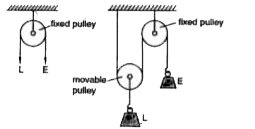Which class of levers has a mechanical advantage always greater than one? What change can be brought about in this lever to increase its mechanical advantage?
Step-by-Step Solution
1. Identify the Class of Lever:
The question asks which class of levers has a mechanical advantage always greater than one. The answer is the second class lever.
2. Understanding Mechanical Advantage:
Mechanical advantage (MA) is defined as the ratio of the effort arm to the load arm. For a second class lever, the formula for mechanical advantage is:
Mechanical Advantage (MA)=Effort ArmLoad Arm
3. Characteristics of Second Class Lever:
In a second class lever, the load is positioned between the fulcrum and the effort. This arrangement ensures that the length of the effort arm is always greater than the length of the load arm. Therefore, the mechanical advantage is always greater than one.
4. Increasing Mechanical Advantage:
To increase the mechanical advantage of a second class lever, we can manipulate the lengths of the arms. Since the effort arm is constant, we can decrease the length of the load arm.
5. Practical Adjustment:
This can be achieved by moving the load closer to the fulcrum. By reducing the distance from the fulcrum to the load, the load arm becomes shorter, which increases the mechanical advantage.
Summary of the Solution
- The class of lever with a mechanical advantage always greater than one is the second class lever.
- To increase its mechanical advantage, decrease the length of the load arm by moving the load closer to the fulcrum.
The question asks which class of levers has a mechanical advantage always greater than one. The answer is the second class lever.
Mechanical advantage (MA) is defined as the ratio of the effort arm to the load arm. For a second class lever, the formula for mechanical advantage is:
Mechanical Advantage (MA)=Effort ArmLoad Arm
In a second class lever, the load is positioned between the fulcrum and the effort. This arrangement ensures that the length of the effort arm is always greater than the length of the load arm. Therefore, the mechanical advantage is always greater than one.
To increase the mechanical advantage of a second class lever, we can manipulate the lengths of the arms. Since the effort arm is constant, we can decrease the length of the load arm.
This can be achieved by moving the load closer to the fulcrum. By reducing the distance from the fulcrum to the load, the load arm becomes shorter, which increases the mechanical advantage.
- The class of lever with a mechanical advantage always greater than one is the second class lever.
- To increase its mechanical advantage, decrease the length of the load arm by moving the load closer to the fulcrum.
Similar Questions
Knowledge Check
The lever for which mechanical advantage is less than one has
Athe fulcrum between the load and the effortBload between the effort and the fulcrumCeffort between the fulcrum and the loadDload and the effort acting at the same pointWhich of the following have mechanical advantages more than 1 always?
ALever of first groupBLever of second groupCLever of third groupDNone of theseWhich of the following have mechanical advantages more than 1 always?
ALever of first groupBLever of second groupCLever of third groupDNone of these
Hydraulic press is based upon
View SolutionDefine mechanical advantage of a lever.
View SolutionA lever has a mechanical advantage of 10. What load in newtons, can be moved by an effort of 6 newtons.
View SolutionHow can the mechanical advantage of a screw jack be increased?
View Solution
If the two-pulley system is 75% efficient, what is its mechanical advantage?
View Solution
